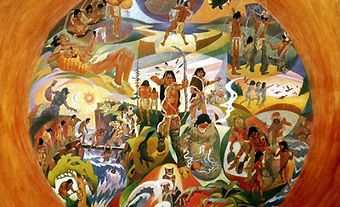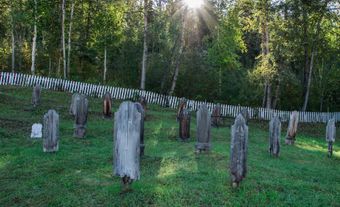Bahá’í Faith is a world religion with members in 235 countries and territories, and with 184 National Spiritual Assemblies. As of 2015, there were an estimated 30,000 Bahá’ís in Canada, a number that includes Francophones and Anglophones living in 1,200 communities. An estimated 18 per cent of the Bahá’í community in Canada are Inuit or First Nations people, while recent Canadians immigrants make up 30 per cent.

Origin
The forerunner of the Bahá’í Faith is the Babi movement, the latter having its historical origins in Iranian Shiism. (See Islam.) However, the Bahá’í Faith is independent rather than a sect of another religion. It derives its inspiration from its own sacred scriptures. These consist primarily of the writings of the founder, Baha’u’llah (1817‒92). The Bahá’ís believe he is the Messenger of God to our age, the most recent in a line stretching back beyond recorded time and including Abraham, Moses, Krishna, Buddha, Christ and Muhammad.
Teachings
According to Baha’u’llah, mankind is one human race that needs to unify into one global society. His teaching state that there is only one God, and all great religions share a divine source as well as the essential goal of guiding and educating people. Among the principles of justice on which the religion is based are gender equality, the right of all people to education, the duty of each person to seek the truth for himself or herself, the closing of the gap between the rich and the poor, the abolition of all forms of prejudice and the need for the establishment of a democratic world government with its own peacekeeping force.
Bahá’ís believe that all great religions of the past have been stages in the progressive revelation of what Baha’u’llah called “the changeless Faith of God.” God himself is unknowable. From age to age he reveals himself through his messengers, whose lives and teachings reflect the Divine qualities. These successive revelations have provided the chief impulse in the civilizing of human nature and the evolution of human society. Other messengers will follow Baha’u’llah so long as the universe exists. The challenge of the next thousand years will be to realize Baha’u’llah’s vision of world unity and social justice.
The Bahá’í Faith holds that a fundamental harmony underlies and connects science and religion — two fields of knowledge that rely on each other and that are essential to human evolution. Without science, religion becomes superstition and fanaticism; without religion, science is a simple instrument of materialism, which does not ultimately lead to authentic well-being.
This lifelong process occurs as the individual learns to serve humanity by responding to the message of God and, in the process, develops his or her own spiritual, moral and intellectual capacities. Prayer, meditation on the creative Word, and the discipline of one’s physical nature are necessary aids to this effort. For Bahá’ís, service to humanity consists of volunteering and becoming actively involved in community development projects. All members of the community, regardless of age, are encouraged to participate in such activities.
History of the Bahá’í Faith
The Bahá’í Faith began in 1844 in Persia (now Iran), with the announcement of the new age by Baha’u’llah’s forerunner, known as the Bab (“The Door”). The Bab (1819‒50) and several thousand Persian followers were regarded by the Muslim clergy as heretics. They were persecuted and killed. Baha’u’llah was imprisoned and eventually exiled to the Turkish penal fortress of Akka, on the bay of Haifa in present-day Israel. The shrines where the Bab and Baha’u’llah lie buried are today the focal points of an imposing complex of gardens and institutions.
By 2015 over 2,100 ethnic groups were represented in the 116,000 Bahá’í centres established worldwide. Persecution of Iran’s 300,000 Bahá’ís for refusal to recant their faith intensified under the regime of the Ayatollah Khomeini and became a systematic campaign by the current Islamic Republic aimed at extirpating the faith in the land of its birth.
Global Community
Bahá’ís have no clergy. The affairs of the community are governed by democratically elected councils locally, nationally and internationally. At the lower two levels the councils, known as Spiritual Assemblies, are elected each year. The supreme governing body, the Universal House of Justice, whose seat is at the faith’s world headquarters on Mount Carmel, Haifa, is elected every five years. Because of its beliefs, the Bahá’í Faith places great importance on co-operation with all efforts toward world unity. The body which represents it in international affairs, the Bahá’í International Community (BIC), holds consultative status as one of the nongovernmental organizations at the United Nations (UN). The BIC also takes an active part in many of the UN’s humanitarian and educational activities. The community has offices close to UN headquarters in New York, Geneva and Brussels. In 2012, it established an office at the European Union in Brussels, where it also has representatives.
Bahá’í Faith in Canada
Canada has played an important role in Bahá’í history. It is significant that after a visit to Montréal, Abdu’l-Bahá, one of the founders of the faith, called on the Bahá’í communities in North America (United States and Canada) to take the lead in the promotion of Baha’u’llah’s teachings worldwide. The global Bahá’í community today is a testimony to the devotion and efficiency with which they responded. In 1937, one of the community’s members, Mary Sutherland Maxwell of Montréal, married the great-grandson of the founder of the Bahá’í Faith, Shoghi Effendi Rabbani. The latter had a central role as the Guardian of the Cause until his death in 1957.
Canadian Bahá’ís are grateful for the energetic efforts of successive Canadian governments who have intervened on behalf of their persecuted co-religionists in Iran. (See also Iranian Canadians.) In June of 1980, the Canadian Parliament was the first legislature to condemn Iran for the religious repression of the Bahá’í Faith.
From 1971 to 2011, 18,945 people of Bahá’í faith immigrated to Canada and established themselves in the country.
Canadian Bahá’í Architects and Artists
The Canadian community has had a particularly close connection with the design of the faith’s many shrines and houses of worship around the world. Two Montréal Bahá’í architects, William Sutherland Maxwell and Jean-Baptiste Louis Bourgeois, designed, respectively, the Shrine of the Báb on Mount Carmel in the Holy Land and the first House of Worship in the western hemisphere at Chicago, Illinois. In 1986, the Vancouver Bahá’í architect Fariborz Sahba created the extraordinary “Lotus Temple” in New Delhi, India, which has won acclaim in the international architectural press.
Still another Vancouver Bahá’í, Hossein Amanat, is responsible for the design of the complex of monumental marble edifices constituting the faith’s international administrative centre in Haifa, Israel, on the slopes of Mount Carmel. A fifth Canadian Bahá’í architect, Siamak Hariri of Toronto, won the competition for the design of the “Mother Temple” of South America in Santiago, Chile.
Internationally renowned Canadian Bahá’í painter and sculptor Otto Donald Rogers was a leading figure of the faith in Saskatchewan. He has written prolifically about the religion, which occupies an important place in his artistic oeuvre.
International Influence of the Canadian Community
Canadian Bahá’ís work in countless community-development projects. Their National Assembly collaborates with Global Affairs Canada (GAC) and the International Development Research Centre on a range of activities. The Canadian community has made submissions to various commissions (such as the Royal Commission on Aboriginal Peoples in the early 1990s). It also participates in national debates on the role of religion in society, equality between men and women (see Gender equality), youth development, human rights and sustainable development.
The Canadian community pioneered the concept of an international organization for Bahá’í studies to bring together scholars and students in an application of Bahá’í principles to various social concerns. The Association for Bahá’í Studies ‒ North America, founded in 1975, has its headquarters in Ottawa. A number of professional associations exist within the faith, such as the Bahá’í Medical Association of Canada.
Composition and Cohesion
The Bahá’í Faith has attracted members from all Canadian provinces and territories and from every ethnic group and social class. Five of the faith’s 274 elected Local Spiritual Assemblies are on First Nations reserves and others, with Inuit members, are in remote Arctic centres. The Canadian National Spiritual Assembly was the first Bahá’í institution in the world to be incorporated formally by a special Act of a sovereign parliament (1949), an example since followed in few other countries. The Bahá’í National Centre is located in Thornhill, Ontario, and the former Maxwell home on Montréal’s Avenue des Pins is maintained as a Bahá’í place of pilgrimage. The Maxwell home is the only Bahá’í shrine outside Israel, Iran, Iraq and Turkey.
A widely used introduction to the faith published in 1985, The Bahá’í Faith: The Emerging Global Religion, was written by two Canadian Bahá’ís, William Hatcher and Douglas Martin.

 Share on Facebook
Share on Facebook Share on X
Share on X Share by Email
Share by Email Share on Google Classroom
Share on Google Classroom


